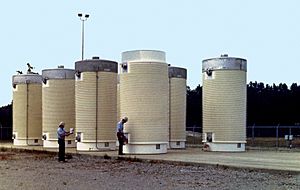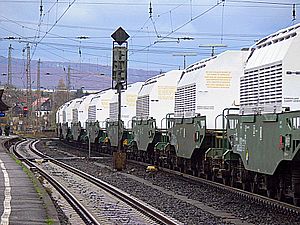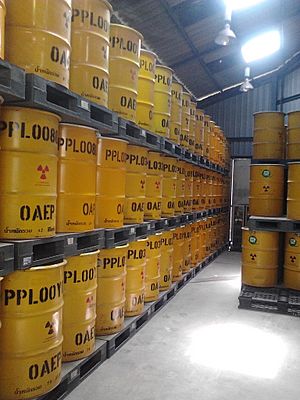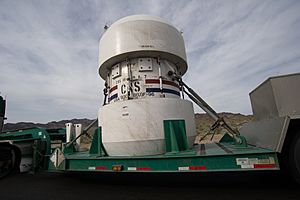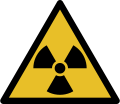Radioactive waste facts for kids
Radioactive waste is a special kind of hazardous waste. It contains radioactive material. This waste comes from many places. These include nuclear medicine, nuclear research, and making nuclear power. It also comes from taking apart old nuclear sites and making nuclear weapons. Governments have rules for storing and getting rid of radioactive waste. This helps keep people and the environment safe.
Radioactive waste is put into different groups.
- Low-level waste (LLW) is like paper, rags, or tools. It has small amounts of radioactivity that fades away quickly.
- Intermediate-level waste (ILW) has more radioactivity. It needs some protection around it.
- High-level waste (HLW) is very radioactive and hot. It needs special cooling and strong protection.
High-level radioactive waste gives off a lot of radiation. This radiation can be harmful.
Radioactive waste is dangerous for the environment. There are many rules about moving, handling, and treating it. These rules help reduce the dangers. This waste can pollute water and harm living things. It must be stored safely for thousands of years. This is until it becomes safe for the environment.
How long radioactive waste must be stored depends on its type. It also depends on the radioactive elements inside it. For a short time, it can be kept on the surface or nearby. For long-term storage, especially for high-level waste, it is often buried deep underground. This is called a deep geological repository. Another way to store it is in dry casks. These are large concrete and steel cylinders. They can hold many tons of high-level radioactive waste.
Some plants can recycle about 96% of spent nuclear fuel. This recycled material is used to make new fuel. The remaining 4% is turned into a glass-like material. This is then stored deep underground. The International Atomic Energy Agency (IAEA) has guidelines for managing radioactive waste. Most developed countries follow these guidelines.
Contents
What is Radioactive Waste?
Radioactive waste contains radionuclides. These are unstable parts of elements. They break down over time, a process called radioactive decay. When they break down, they release ionizing radiation. This radiation can be harmful to people and the environment. Different radionuclides release different types and amounts of radiation.
The radioactivity of all waste gets weaker over time. Every radionuclide has a half-life. This is the time it takes for half of its atoms to change into another element. Eventually, all radioactive waste turns into non-radioactive elements.
Being exposed to radioactive waste can affect your health. This is because of the radiation. Even small amounts of radiation can cause cell damage. If a developing baby is exposed, it could cause birth differences.
Where Does Radioactive Waste Come From?
Radioactive waste comes from several places. In countries with nuclear power plants or nuclear weapons, most waste comes from these activities. Other sources include waste from hospitals and factories. There are also naturally occurring radioactive materials (NORM). These can become concentrated when we process things like coal, oil, gas, and some minerals.
How is Radioactive Waste Managed?
Managing nuclear waste is a big challenge. Some radioactive elements in spent fuel stay dangerous for millions of years. Nuclear waste needs careful handling. It must be kept away from living things. This usually means treating it first. Then, it needs a long-term plan for storage, disposal, or changing it into a non-toxic form. Governments around the world are looking at different ways to manage this waste. But finding long-term solutions is still a work in progress.
Scientists have looked at many ways to get rid of radioactive waste:
- Deep geological repository: Burying it deep underground in stable rock.
- Dry cask storage: Storing it in strong, sealed containers.
- Deep borehole disposal: Burying it in very deep, narrow holes. (Not used yet).
- Rock melting: Trying to melt the waste into rock. (Not used yet).
- Ocean disposal: Putting it in the ocean. This is now against international rules.
- Disposal in ice sheets: Putting it in ice. This was rejected.
- Deep well injection: Pumping it into deep wells.
- Nuclear transmutation: Changing harmful atoms into less harmful ones.
- Nuclear reprocessing: Recycling some radioactive materials for reuse.
- Disposal in outer space: Sending it into space. (Too expensive and risky).
In the United States, a planned deep storage site called Yucca Mountain was not finished. Now, spent fuel is stored at 70 nuclear power plant sites. A special group was formed to find new options for this waste. Burying it deep underground seems to be the preferred method.
Special materials like Ducrete, Saltcrete, and Synroc can help make nuclear waste stable.
Accidents and Safety
A few accidents have happened with radioactive material. Sometimes, it was not stored properly. Other times, its protective cover was faulty. Or it was simply left behind or even stolen.
In the Soviet Union, waste stored in Lake Karachay was spread by a dust storm when the lake dried up. At Maxey Flat in Kentucky, trenches holding low-level waste filled with water during heavy rain. This made the water radioactive.
In other cases, lakes or ponds with radioactive waste overflowed into rivers during big storms. This contaminated drinking water. In France in 2008, liquid containing uranium leaked from a faulty tank. About 75 kg of radioactive material went into the ground and nearby rivers. Over 100 workers were also exposed to low levels of radiation. There are also worries about an old nuclear waste site on the Enewetak Atoll in the Marshall Islands. There is a risk of a radioactive spill there.
Finding and taking abandoned radioactive material has caused several radiation exposures. This happens mostly in developing nations. These places might have fewer rules about dangerous items. People might also know less about radiation dangers. They might pick up the material for its looks or scrap value. The owners of the material, like hospitals or universities, sometimes act carelessly. A lack of rules or not enforcing them also plays a big part. For example, the Goiânia accident happened when people found radioactive scrap from a hospital.
Accidents involving spent nuclear fuel during transport are unlikely to be serious. This is because the containers used are very strong.
In 2011, the Japanese government confirmed that nuclear substances were found in waste from Japanese nuclear facilities.
Hazard Warning Signs
Images for kids
See also
 In Spanish: Residuo radiactivo para niños
In Spanish: Residuo radiactivo para niños


